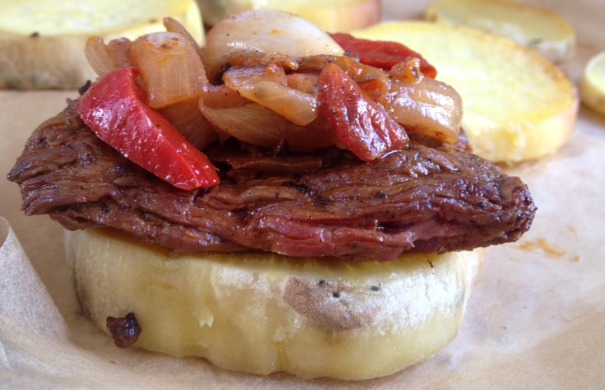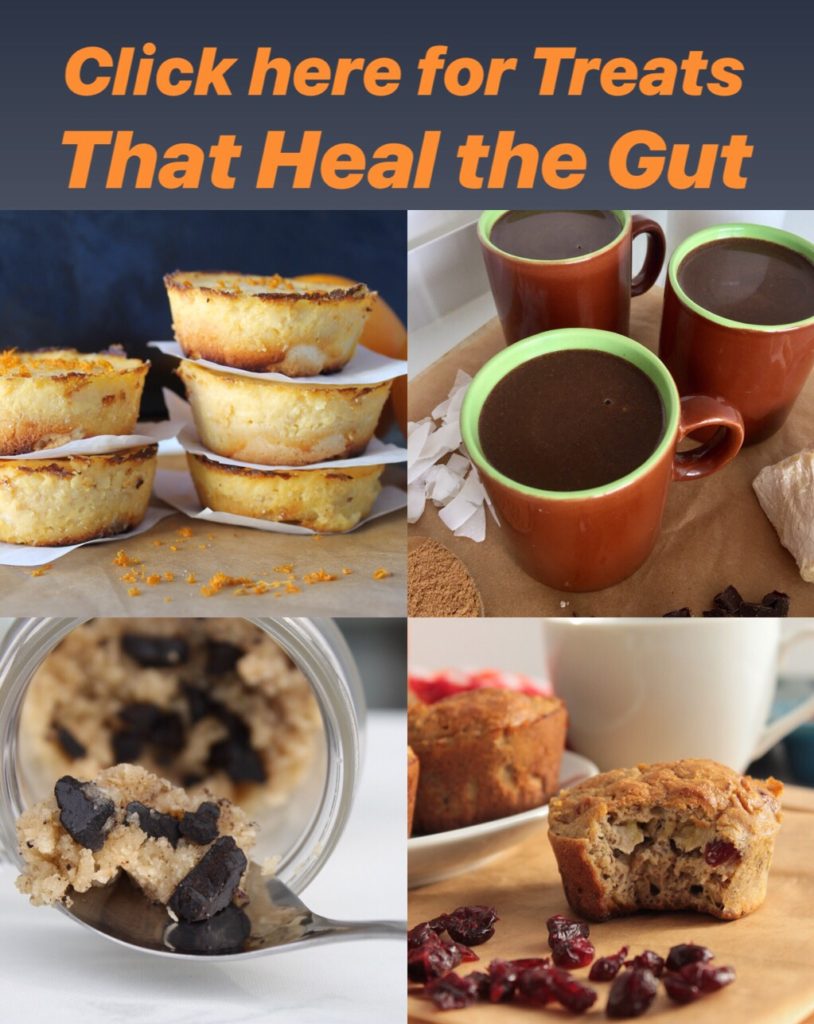While diet is not everything, it is a large part of the healing process. What you eat determines in part what kinds of bacteria you have, how stable your blood sugar is and how much inflammation you have.
The Paleo diet is responsible for healing me almost 9 years ago. But I wasn’t eating Paleo cupcakes, I had to tweak my version of Paleo to accommodate my food sensitivities.
People e-mail me sometimes, saying that Paleo did not work for them. Even though something is allowed on the Paleo diet, doesn’t mean it’s going to agree with your gut. The Paleo diet is a template characterized by the foods it excludes.
Eating sugar, wheat, beans, inflammatory oils and most grains is not going to do your belly any favors. And even if safe starches, like as white rice, don’t make your symptoms worse, they’re not moving you towards better digestive health either.
Making the Paleo diet work for you is a matter of tweaking. Just because a food is allowed on Paleo or a similar diet, doesn’t mean you can tolerate it. Foods like nuts, seeds, dairy, fruit, eggs and honey are examples of common foods that are allowed on the Paleo diet but may be the reason that Paleo is not working for you.
Discarding Paleo because it didn’t work may not be the best solution. But tweaking the diet to address your body’s unique needs and sensitivities may be the better way to go.
If you’re still not convinced about Paleo’s healing powers, here are some studies that might impress.
Grain-free statistics
A pilot study done on Irritable Bowel Syndrome put patients on a Paleo-based diet called the Specific Carbohydrate diet. It differs from Paleo in that it allows fermented dairy, green beans and limits starchy veggies. The study’s results:
“Notably, 9 out of 11 patients were able to be managed without anti-TNF therapy, and 100% of the patients had their symptoms reduced.” – http://eschweolarship.umassmed.edu/cgi/viewcontent.cgi?article=1025&context=cts_retreat
Also, there’s been more than a 90% success rate reported by various doctors internationally. Dr. Jean Seignalet in France conducted a trial on autoimmune patients, with success being defined as 50% reduction in symptoms. Here are the results:
It helped 98 percent of the patients with IBS, with a 220 person sample size.
It also helped 100 percent of patients with Crohns with a 40 person sample size, 80 percent of people with rheumatoid arthritis (200 person sample size) as well as 85 percent with chronic fatigue syndrome (11 person sample size).
When Paleo doesn’t work
So how do you tweak Paleo?
This is how I did it. I cut out nuts, dried fruit, all sweeteners and chocolate. I couldn’t even have black tea.
Today, Paleo seems to be about recreating the healthy version of your favorite junk food like Paleo donughts sweetened with honey. This may be fine for a relatively healthy person to eat but if you are healing your digestion, I suggest staying away from Paleo treats and baked goods. Until you heal that is. Then go to town.
Cutting out the high risk foods above and then adding them back in one by one is a way to test your reaction to them. Another way is to keep a food journal and write down your reactions to specific foods. You will begin to see a pattern over time. Allergy testing is another method for determining what does and doesn’t work for you, but those tests don’t always pick up everything.
Below, I’ll discuss some common red flag foods for healing, all of which are allowed on the Paleo diet. It’s a good place to begin testing your tolerance level.
One note about the power of Paleo. Once you commit yourself to a healing diet, your gut bacteria will be unforgiving. There is no cheating if you want it to work. This isn’t a diet to lose weight where one slip up is no big deal. One slip up can make you feel like you are back at day one. It can trigger a painful IBS episode and feel extremely discouraging.
So remember, Paleo (or any healing diet) will not be kind to you unless you are faithful. So commit only when you are 100 percent ready. Cheating is never worth it.
The best place to start
The diet that most closely resembled my healing diet is something called The Whole 30. It’s a 30 day Paleo cleanse that doesn’t allow any sweeteners, dried fruit, nut flours or dairy products. It’s a simple diet comprised of healthy fats, moderate fruit intake, veggies and animal protein. It provides shopping list and lots of tips on how to be successful. For example, planning ahead is crucial!
Because it’s the strictest version of Paleo I think it’s the best place to start if you want to see the greatest results.
The Specific Carbohydrate Diet and the GAPs diet, both based on Paleo but with the addition of fermented foods and bone broth are also great places to start. I write all about these diets here..
And if you’ve tried the diets above and they didn’t work for you, consider trying some of the tweaks below.
Autoimmune Paleo diet
People who have autoimmune diseases like lupus, Chron’s, celiac disease, or hashtimotos thyroiditis should follow an autoimmune version of Paleo. It is believed that the root cause of autoimmune conditions is caused by leaky gut. Adding bone broth to this dietary protocol is crucial for sealing the tiny holes in the gut.
Leaky gut will lead to multiple food sensitivities. The most common foods to avoid with the autoimmune protocol are all nuts or seeds (including chia and flax), dried fruit, eggs, nightshade veggies (tomatoes, peppers, eggplant, potatoes), chocolate and dairy.
Low FODMAP Paleo diet
I’ve written a lot about the low FODMAP version of the Paleo diet here and here. High FODMAP foods are an acronym for foods that have certain compounds that don’t break down and digest well in the body and produce carbon dioxide gas in the gut as they are eaten by bacteria. A reason, perhaps, for that nasty gas and bloating.
Some people believe that high FODMAP foods are most irritating for people who have small intestinal bacterial overgrowth (SIBO). High FODMAP foods are typically considered healthy by most people, for example the cruciferous veggie family (broccoli, cauliflower, cabbage and brusell sprouts) or fruits like apples and pears, are high FODMAP.
Lactose is also not tolerated on the FODMAP diet. Also, people with SIBO don’t do well with fermented foods like kombucha and sauerkraut. They must be careful about the type of probiotics they take, making sure there are no prebiotics or inulin in them.
So as you can see, the rules for treating SIBO are quite different. If you suspect you may have a SIBO issues get a hydrogen breath test. You can find a local SIBO test center here.
Even some people who do not have SIBO can have problems digesting high FODMAP foods or foods high in insoluble fiber. This is a promising diet that has been shown to help some people with IBS.
IBS and fructose malabsorption
Some people with IBS and/or SIBO have issues with digesting the fructose found in fresh fruit.
Fruit should always be eaten alone, half an hour before a meal or and hour and a half afterwards. And taking fruit out of the diet for a week or two and then adding it back in will let you know if this is your issue.
You may only react to high FODMAP fruit like apples and pears, so test for both high and low FODMAP fruit.
Candida diet
The more I study the candida diet, the more I realize that conventional wisdom about treating this condition is wrong.
The idea has been to starve the body of sugar, leaving fruit out of the diet and restricting starches. If candida, which is an opportunistic yeast, is starved of its sugar food source it will start finding internal sugar sources in the body, sometimes feeding on blood glucose.
For candida it is more important to avoid eating moldy foods like mushrooms and nuts. It’s also a good idea to avoid eating leftovers, which quickly grow fungus and molds.
Going grain free can be enough to slowly starve the candida, without creating massive die off symptoms. Adding garlic, oregano oil and apple cider vinegar to the diet is also important for killing candida.
This is a great blog on candida.
Histamine intolerance
This issue is much more obscure. Only 1 percent of the population suffers with it. But I wanted to add it in case this is the missing piece for someone.
You can get a skin prick test for histamine intolerance to determine if you have it, but if you feel worse when you eat fermented, smoked or aged food like: aged cheese, yogurt, kombucha, kefir, sauerkraut/kimchee, canned fish or smoked meat, it’s a good reason to get tested.
Veggies like spinach, eggplant, mushrooms, tomatoes, canned vegetables, dried fruit, avocados, strawberries, papaya, pineapple, and leftovers can also pose a problem for histamine intolerance.
Histamine symptoms are reminiscent of hay fever: a runny nose, swollen throat and eyes and itchiness as well as rashes and hives. It can also cause migraines, constipation or diarrhea, nausea and low blood pressure.
If this sounds familiar to you, read more about this condition here.
Kidney issue and oxalates
I heard the craziest story from a fellow health coach about her super healthy, mostly raw, alkaline diet.
She drank lemon water all day and had multiple green smoothies or juices with lots of spinach and berries. She snacked on nuts and dark chocolate. Sounds pretty perfect right?
Well, she ended up in the hospital with kidney stones because the healthy foods she was consuming were high in oxalates. She was really overdoing it.
Her experience taught me an important lesson, that overdoing healthy foods can be a problem. More is not better. In her overzealous quest for perfect health, this woman ruined hers.
While not everyone has a problem with high oxalate foods like spinach, swiss chard, berries, kiwis, nuts, beets, chocolate and black tea, overdoing these foods may irritate the kidneys. And if oxalates are an issue for you, they can cause digestive issues, kidney stones and worsen inflammatory conditions like fibromyalgia.
The point is not to fear the healthy high oxalate foods, but to understand why overdoing it and faddish juice cleanses and raw food diets can cause more issues than they solve, despite their popularity.
I’ve never been a fan of raw food for people who suffer with digestive issues. Aside from fruit, I believe most foods should be well cooked in the initial healing stages.
Thryoid issues and goitrogens
Another reason not to consume raw veggies are goitregens. Goitregens naturally occur in some raw veggies and may cause an enlargement of the thyroid gland and thyroid problems. Again this issue applies to only a small percentage the population, but it is still worth mentioning.
Veggies like bok choy, cabbage, broccoli, spinach, cauliflower, kale, collards and brussel sprouts all contain a high level of goitrogens. When cooked, the goitrogen content decreases considerably. But when eaten raw, in smoothies or juices, these healthy veggies can do damage to some people.
Yet another reason that I’m not a fan of juice fasts. I think they have can over deliver both healthy and unhealthy substances in these foods.
How much raw spinach can someone eat? But in smoothie or juice form, it is easy to get an overdose.
Just a cautionary tale about moderation!
Fermented dairy and IBS
Dairy seems to be second only to gluten on the list of foods people can’t tolerate.It is best avoided. However, fermented dairy is much easier to tolerate due to the probiotic content.
Fermented dairy like yogurt and kefir is becoming very popular. Some people experience massive bacterial die off reactions from fermented dairy. This makes it hard to tell if you’re body doesn’t tolerate dairy or if it’s having a detox effect.
With all fermented foods, but particularly fermented dairy it’s always a good idea to start with miniscule amounts, like a teaspoon a day and slowly, incrementally work up to larger doses.
To sum up
While I’ve thrown a lot of information at you, it’s not my intention to overwhelm. Working with a nutritional professional can be helpful in finding the diet that best works for you. If this seems overwhelming just yourself some good, knowledgeable support.
The main point I hope you’ll take away from this is that Paleo and other grain-free diets needs to be tweaked to be most effective. Here are the top foods to start testing and tweaking.
Dairy
Nuts and seeds
Sweeteners like honey, maple syrup, etc.
Eggs
Also watch your veggie intake and notice which ones make you feel better versus worse. Also make sure you don’t eat veggies raw and eat them in moderation.
And if you have an issue of intolerance to multiple foods, too many even to name, then the issue is most likely leaky gut. I will address healing leaky gut in an upcoming blog.
Diet may not be the whole answer
Another reason that diet may not work is that there may be other problems to address first, like gut infections, intestinal permeability or hormonal imbalance.
Also you may have an obscure food allergy to something like coconut. So just notice how certain foods make you feel.
Also there are things that can get in the way of eating healthy and these need to be dealt with first.
Dealing with emotions and emotional eating may be the first step of the process.
Or putting all your effort in finding the perfect diet and ignoring all other aspects of your healing can also be missing the point. While diet is important we are more than what we eat. We are what we think, feel and experience.
Dealing with stress and overwhelm in your life is just as important and finding the perfect diet.
If diet causes stress and overwhelm then it’s counterproductive. Worry less about following someone else’s idea of the perfect diet and find something that works for you.
Transition slowly or quickly but always be gentle and kind with yourself. Try not to cheat, but if you do, forgive yourself quickly. You pave the path to healing with your body, soul and mind.
 Angela Privin is proof that IBS is NOT an incurable disease or a disease at all. IBS is a body out of balance. It’s an invitation for change. After solving her own IBS mystery more than a decade ago Angela trained as a health coach to help others.
Angela Privin is proof that IBS is NOT an incurable disease or a disease at all. IBS is a body out of balance. It’s an invitation for change. After solving her own IBS mystery more than a decade ago Angela trained as a health coach to help others.
Angela uses both science and intuition to help people figure out what’s out of balance in their body. She works with lab tests, dietary changes, supplementation and nervous system rebalancing. Get help rebalancing your digestive system and solving your IBS mystery here.







2 Comments